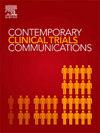腹腔镜腹膜内补片修复切口疝的标准化:对临床结果和生活质量的影响(LIPOM试验,NCT 02089958)
IF 1.4
Q4 MEDICINE, RESEARCH & EXPERIMENTAL
引用次数: 0
摘要
目的:由于手术技术和医疗器械的使用存在大量的可变性,目前可用的腹腔镜腹腔内补片修复术(IPOM)治疗切口疝(IH)的结果数据在有限的程度上具有可比性。在这项前瞻性观察性多中心队列研究中,我们评估了共识驱动的IPOM标准方案的影响,即在双冠技术中使用可吸收的钉固定网片,在网片边缘使用额外的不可吸收的经筋膜缝合线,同时使用Physiomesh™,对临床和患者报告的结果进行测量。方法2013年9月至2014年10月共筛选102例患者。85例患者(IH: EHS W1: n = 39, W2: n = 46)纳入研究。在基线、住院期间以及随访6周、6个月和1年时进行临床检查和PROM疼痛和生活质量测量(Carolina Comfort Scale, CCS)。结果主要终点随访率为87.1%。Kaplan-Meier估计1年的复发自由度为95.9% (95% -CI: 87.9 - 98.7%), 1年的累积复发率为4.1% (95% -CI: 0.9 - 11.7%)。无术中并发症。1个血清瘤(I型;1/84 (1.2%), 95% (ci: 0 - 7.1%)在住院期间被诊断。12血清肿(n = 12/74 (16 2%), 95% ci: 9.4 - -26.4%;随访期间诊断为II型10例,IV型2例,需要手术治疗1例(1.4%,Clavien Dindo分级IIIb)。随访中发现皮下血肿8例(8/75 (10.7%));95% -CI: 5.3-19.9), 2例患者需要手术干预(2.7%,Clavien Dindo分级IIIb)。手术部位浅表感染3例(3/74)(4.1%);95% -CI: 0.9 - 11.7%, Clavien-Dindo分级I级),无需再手术。在1年随访中,患者报告的疼痛在基线时为1.36±1.53,在1年随访时为0.35±1.04。CCS总分下降至2.80±6.47分(Min: 0, Q1: 0,中位数:0;Q3: 3.0;最大值:38.0),随访1年。网孔感觉评分从4.01±6.76 (min: 0, Q1: 0, Median: 0;Q3: 5.0;Max: 28.0)至1.67±3.99 (Min: 0, Q1: 0,中位数:0;Q3: 1.0;Max: 21.0), 6个月后0.90±2.69 (Min: 0, Q1: 0,中位数:0;问题3:0;1年随访后最大值:14.0)。疼痛和活动受限评分在随访期间均有所下降,与术前评估相比,1年时显著降低(p <;0.001)。结论:本研究显示了良好的临床和患者报告的结果,在IPOM后1年随访的复发率很低,采用了标准化的手术技术,包括使用Physiomesh™。鉴于导致Physiomesh™退出市场的数据,人们可能会得出结论,所描述的标准可能有助于补偿Physiomesh™组织整合的可疑延迟,从而与带/不带可吸收TFS的可吸收针固定相比,产生更合适的网状固定。这可能会导致一般的评估,即固定技术必须适应不同类型的网状物和固定装置的个体特征以及网状物计划的解剖着陆区。本文章由计算机程序翻译,如有差异,请以英文原文为准。
Standardization of laparoscopic intraperitoneal onlay mesh repair for incisional hernia: Impact on clinical outcome and quality-of-life (LIPOM trial, NCT 02089958)
Purpose
Current available outcome data following laparoscopic intraperitoneal onlay mesh repair (IPOM) for incisional hernia (IH) are comparable to a limited extent only because of a huge number of variability particulary in surgical technique and use of medical devices. In this prospective observational multicenter cohort study we evaluate the impact of a consensus driven standard protocol for IPOM, that is mesh fixation with absorbable tacks in double crown technique enforced by additional non-absorbable transfascial sutures at the edges of the mesh along with the use of Physiomesh™, on clinical and patient reported outcome measures.
Methods
A total of 102 consecutive patients were screened for eligibility between September 2013 and October 2014. 85 patients (IH: EHS W1: n = 39, W2: n = 46) were included into the study. Clinical examination and PROM for pain and quality of life measure (Carolina Comfort Scale, CCS) were performed at baseline, during hospital stay and at 6 weeks, 6 months and 1 year follow-up.
Results
The follow-up rate was 87,1 % for the primary endpoint. The Kaplan-Meier estimate for freedom-of-recurrence at 1 year was 95.9 % (95 %-CI: 87.9–98.7 %), the cumulative recurrence rate at 1 year was 4.1 % (95 %-CI: 0.9–11.7 %). There was no intraoperative complication. One seroma (type I; 1/84 (1,2 %), 95 %-CI: 0–7.1 %) was diagnosed during hospital stay. 12 seroma (n = 12/74 (16,2 %), 95 %-CI: 9.4–26.4 %; n = 10 type II and n = 2 type IV) were diagnosed during follow-up requiring surgical intervention in 1 patient (1,4 %, Clavien Dindo grade IIIb). Subcutaneous hematoma were found during follow-up in 8 patients (8/75 (10.7 %); 95 %-CI: 5.3–19.9) with need for surgical intervention in 2 patients (2,7 %, Clavien Dindo grade IIIb). There were 3 superficial surgical site infections (3/74 (4,1 %); 95 %-CI: 0.9–11.7 %, Clavien-Dindo grade I) without need for reoperation. Patient reported pain as measured by numeric rating scale at baseline was 1.36 ± 1.53 and 0.35 ± 1.04 at 1 year follow-up. CCS total scores indicated a good outcome with a decrease to 2.80 ± 6.47 (Min: 0, Q1: 0, Median: 0; Q3: 3.0; Max: 38.0) at 1 year follow-up. Subscore sensation of mesh decreased from 4.01 ± 6.76 (min: 0, Q1: 0, Median: 0; Q3: 5.0; Max: 28.0) at 6 weeks to 1.67 ± 3.99 (Min: 0, Q1: 0, Median: 0; Q3: 1.0; Max: 21.0) after 6 months and 0.90 ± 2.69 (Min: 0, Q1: 0, Median: 0; Q3: 0; Max: 14.0) after 1 year follow-up. Subscores pain and movement limitation both decreased during follow-up and were significantly reduced at 1 year compared to preoperative assessment (p < 0.001).
Conclusions
This study showed favourable clinical and patient reported outcomes and a low rate of recurrences at 1 year follow-up after IPOM for elective IH applying a standardized surgical technique including the use of Physiomesh™. In view of the data leading to the market withdrawal of the Physiomesh™, one might conclude, that the described standard may have contributed to a compensation of the suspected delay in tissue integration of the Physiomesh™ resulting in a more proper mesh fixation compared to absorbable tack fixation with/without absorbable TFS. This may lead to the general appraisal, that the fixation technique has to be adapted to the individual characteristics of type of mesh and fixation devices and the planned anatomic landing zone of the mesh.
求助全文
通过发布文献求助,成功后即可免费获取论文全文。
去求助
来源期刊

Contemporary Clinical Trials Communications
Pharmacology, Toxicology and Pharmaceutics-Pharmacology
CiteScore
2.70
自引率
6.70%
发文量
146
审稿时长
20 weeks
期刊介绍:
Contemporary Clinical Trials Communications is an international peer reviewed open access journal that publishes articles pertaining to all aspects of clinical trials, including, but not limited to, design, conduct, analysis, regulation and ethics. Manuscripts submitted should appeal to a readership drawn from a wide range of disciplines including medicine, life science, pharmaceutical science, biostatistics, epidemiology, computer science, management science, behavioral science, and bioethics. Contemporary Clinical Trials Communications is unique in that it is outside the confines of disease specifications, and it strives to increase the transparency of medical research and reduce publication bias by publishing scientifically valid original research findings irrespective of their perceived importance, significance or impact. Both randomized and non-randomized trials are within the scope of the Journal. Some common topics include trial design rationale and methods, operational methodologies and challenges, and positive and negative trial results. In addition to original research, the Journal also welcomes other types of communications including, but are not limited to, methodology reviews, perspectives and discussions. Through timely dissemination of advances in clinical trials, the goal of Contemporary Clinical Trials Communications is to serve as a platform to enhance the communication and collaboration within the global clinical trials community that ultimately advances this field of research for the benefit of patients.
 求助内容:
求助内容: 应助结果提醒方式:
应助结果提醒方式:


